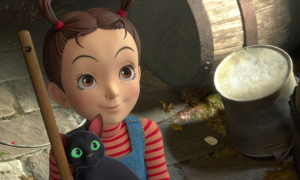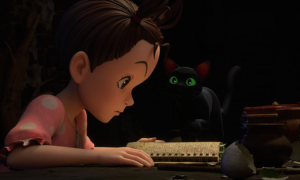Based on a novel of the same name by Diana Wynne Jones, Earwig And The Witch follows the adventures of precocious young orphan Earwig as she is adopted and moves into a Witch’s house where chaos and magic surround everything.
Being the son of the great Hayao Miyazaki must bring its own pressures in life, especially when you go out to make your own directing career – in your father’s studio of all places. But that’s exactly what Gorō Miyazaki (pictured above) has done with Earwig And The Witch and we managed to catch up with the man to find out if the apple falls far from the tree…
How did you first get involved in Earwig And The Witch?
I actually worked with an outside studio on a TV series called Ronia The Robber’s Daughter. After I finished that, Ghibli had disbanded all the creative staff, so when I came back to the studio there was nobody there! I just came into this empty – almost – storage unit. I was about to go on and make another film or go on to do another project with the producers of Ronia The Robber’s Daughter, but that kind of fell through.
Right about that time, Hayao Miyazaki came out of retirement and he was going to make a short film for the Ghibli Museum. After finishing that short film, he went on to make another feature length film and at that time he also suggested that we make a film adaptation of this novel that he thought was a very good story. So he and our producers approached me with [Earwig And The Witch].
Looking back now in hindsight, I feel that Hayao Miyazaki wanted to have not just him but me on board as we start the next chapter of Studio Ghibli after we watched it close down and when he said he would retire.
The movie is based on a novel of the same name by Diana Wynne Jones. What was it about the book that stood out to you?
What drew me to the story the most was Earwig. I like the fact that she wasn’t your typical good girl. She could probably be the most anti-good person in the book. But then, when you read through it, if you think about the circumstances she was in, she’s an orphan, there’s nothing she can do about that, but she is someone who is not passive. [She] actively tries to make something positive out of the situation by being very active, and also very clever, in her own way. That was something that really drew me to her.

What was the process of adapting a book like? How did you get started?
So obviously, the first thing you do, is you write the script with the writer. But for me what’s important, oftentimes, is to think about how the film is going to start. So I really work on the storyboard at an early stage of production. Once you have that first introduction into the film, when you understand how it starts, then you’re able to move on further into the story. But without that I struggle to put the whole film together in my head!
What was the most challenging part of the process?
Everything about it was challenging haha! Probably the biggest challenge was that since this was my first full 3D CG it was quite difficult to find the right balance for the visuals. When it’s hand-drawn, it’s easy to know what it’s going to look like on-screen; how the colours are going to look like. If you’re doing a night scene, you know how much darkness you want and you can have an image in your mind how it’s going to look on screen.
However, with 3D CG, it took a lot of time for me to figure out or understand how dark I could go and how the colour would come out. Especially with this film – a lot of things take place in the very dark and dirty workshop of the witch, so trying to figure out the right balance [of] the brightness and the darkness was very quite challenging.

Where did the inspiration for the look of the film come from?
The technique or the approach may be different [but] I definitely wanted to have that Ghibli sensibility in the look. Also, in the Japanese translated version of the original novel, there was an elegant illustration in the book by Miho Satake. Her illustration was a big inspiration to me, how she captures that, even though the workshop is very dirty, it’s very cluttery, there’s a beauty in that because it’s very colourful and very detailed. So that was something I wanted to make sure I captured.
What would you like audiences to take away from Earwig And The Witch?
It’s hard to explain. I don’t know about other countries in the world but here in Japan, there’s a lot of ‘you should do this’ or ‘things should be done this way’, and you’re constantly trying to meet peoples’ expectation. That causes a lot of pressure on people and that can hurt people a lot. You’re not able to do what you really want to do. But, when you really narrow it down, there are not many things in life that you shouldn’t do. Obviously, you shouldn’t hurt other people’s feelings or you shouldn’t hurt people physically, but you are a free person to do whatever you want in life, as long as you don’t hurt other people. There shouldn’t be that much restriction forced upon them.
So I would really like young people, especially young people, who see this film to overcome those restrictions, the limitations that are forced upon them, and to live their own life. Probably the theme song in the film captures the theme most, like when they say ‘don’t disturb me’, basically [it’s saying] ‘I’m trying to live my own life, so don’t get in my way, leave me alone!’.
Earwig and the Witch is coming to cinemas on 28th May, check out the trailer here. Get tickets and find out more here.
